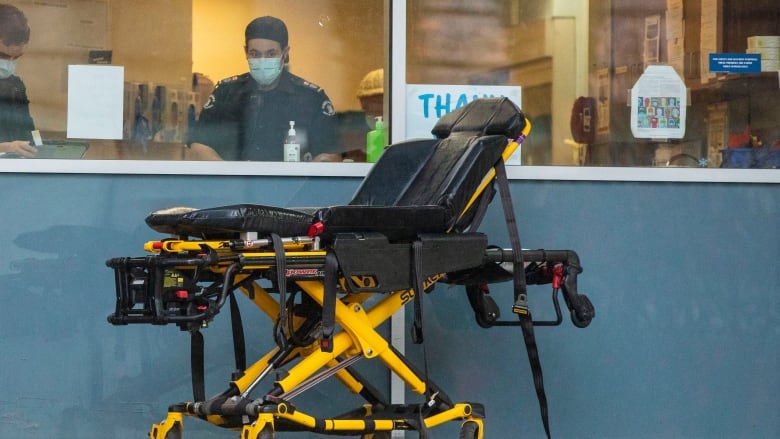We looked at data on temporary closures, reduced services in B.C. hospitals this year. Here's what we found
Hospitals announcing reduced services closed for over 16 hours on average, according to data verified by CBC

This story is part of Situation Critical, a series from CBC British Columbia reporting on the barriers people in this province face in accessing timely and appropriate health care.

B.C.'s health-care system is experiencing historic pressures as a result of the ongoing COVID-19 pandemic and staffing shortages, which have led to numerous service reductions and emergency room closures, primarily in rural areas.
CBC News has independently verified data tracking ER closures across the province, as well as diversions and closures of maternity units.
We found hospitals in B.C.'s Interior have experienced the most ER closures this year, and hospitals that announced reduced services were closed for more than 16 hours on average. Most of those closures were outside the province's major urban centres.
No community, however, has been more affected than Clearwater, a district 120 kilometres north of Kamloops, with a little over 2,300 residents.
The Dr. Helmcken Memorial Hospital in Clearwater has had its emergency department closed for a total of 375 hours this year, more than 15 days in total. This week alone, four closures were announced for the ER.
"In the height of tourism season, with locals doing all the things that they like to do, which generally involves power tools and things that take off fingers and the like, it's very challenging for locals," said Clearwater Mayor Merlin Blackwell on Tuesday.
"I know of multiple … incidents where people either waited out the ER closure and came in after it, or went to Kamloops and waited for hours and hours and hours."
Blackwell said the community is also home to Trans Mountain Pipeline workers, further putting a strain on health-care resources.
Nearly all of the hospital closures have been blamed on staffing shortages, a recurring issue over the course of the pandemic.
Blackwell said he had positive discussions with provincial leaders about attracting more workers to Clearwater. But given that most of the hospital's ER closures have happened since April — almost once a week since then — he said he is concerned for the summer.
"The biggest concern for me is getting this stabilized," he said. "I think help is on its way in a big, focused way by Interior Health. That's a change that I really haven't seen in [a] year and a half or so."
Interior Health said in a statement that it is actively recruiting for additional staff in Clearwater and beyond.
"Human resource challenges are occurring in every sector right now and health care is not immune to this," they said.
"When we make the difficult decision to close a rural emergency department, patient safety is always top of mind."
Most closures occur during the weekend
In June, Crystal Mundy, a psychologist from B.C., set up a website tracking hospital closures in the province. CBC News has independently verified data on the site, referencing notices on health authority websites and closure announcements.
"It seems like outside of health-care, which is an area I'm working in right now, a lot of people don't really see or understand the big picture," Mundy said. "I thought there was a very direct need to have some sort of centralized service of data to show people what's going on."
The data showed that B.C. hospitals reduced services most often on weekends, with an average closure time of over 16 hours. The single longest closure was a 36-hour period at the Ashcroft Hospital in the Interior, in April.
Mundy said the fact that the province does not make information on hospital closures and service reductions easily accessible shows a lack of transparency.
She also said the concentration of closures in rural areas is symbolic of years-long underfunding for areas outside urban centres.
"It's a factor of that power differential that we get," she said. "That, sometimes, unwillingness to foster resources in rural areas and that divide that we see."
In a statement, B.C.'s health ministry said there were protocols in place ensuring patients requiring emergency care are treated in a timely fashion.
"All health authorities continue to aggressively recruit for vacancies to ensure diversions become less frequent in the future," a spokesperson said in a statement.
"Additionally, the Real-Time Virtual Support service, launched in 2020, helps keep rural and remote ERs open. The service gives nurses, nurse practitioners and physicians access to virtual support from ER physicians."
Ongoing closures in communities
Though many of the closures and service reductions at B.C. hospitals were temporary, some communities have had to deal with closures that are indefinite, or lasting multiple months.
This includes the maternity ward diversion at Lady Minto Hospital, on Salt Spring Island, expected to last until mid-August, and the indefinite closure of the in-patient wing at Boundary District Hospital in Grand Forks, in the southern Interior.
Grand Forks Mayor Brian Taylor told CBC News the community hasn't yet experienced an emergency situation involving the in-patient ward.
But he also said Interior Health has not told him when the hospital would be fully operational.
"Our community is working really hard with Interior Health to look at things like housing and how to better attract people to our community," he said. "But that's not a short-term solution.
"I don't believe at this point that money is the only problem. I think we've got other issues to deal with."
In an emailed statement, Interior Health said recruitment efforts are ongoing for Boundary District Hospital.
With files from Daybreak Kamloops

